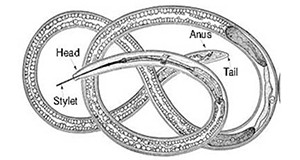
Dagger nematodes parasitize plants. They cause economic damage and death of host crops through feeding on the roots and by spreading viral mosaic and wilting diseases, but field studies have shown that some control measures targeting reduction in the population of dagger nematodes can be effective in controlling viral diseases in susceptible crops. This 7-page fact sheet was written by William K. Heve, William T. Crow, and Tesfamarian Mengistu, and published by the UF Department of Entomology and Nematology, June 2015.
http://edis.ifas.ufl.edu/in1097
Category: Crops
Snap Bean Soil Fertility Program in Miami-Dade County
In terms of acreage, snap beans are the most commonly grown vegetable in Miami-Dade County. This 2-page facts sheet outlines the impact of fertilizer use and local weather and soil on snap bean production in this region. Written by Monica Ozores-Hampton, Qiang Zhu, and Yuncong Li, and published by the UF Department of Horticultural Sciences, May 2015. http://edis.ifas.ufl.edu/hs1261
Sample Pollination Agreement
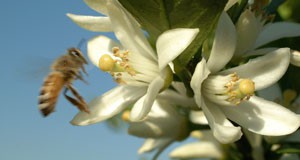 The key to a prospering pollination service is proper promotion, honest, quality service, and a written contract. This contract would detail the expectations of both the beekeeper and the grower. This 4-page fact sheet provides a suggested pollination agreement. Written by Malcolm T. Sanford, Jeanette Klopchin, and James Ellis, and published by the UF Department of Entomology and Nematology, March 2015. (UF/IFAS Photo: Thomas Wright)
The key to a prospering pollination service is proper promotion, honest, quality service, and a written contract. This contract would detail the expectations of both the beekeeper and the grower. This 4-page fact sheet provides a suggested pollination agreement. Written by Malcolm T. Sanford, Jeanette Klopchin, and James Ellis, and published by the UF Department of Entomology and Nematology, March 2015. (UF/IFAS Photo: Thomas Wright)
http://edis.ifas.ufl.edu/aa169
Thrips in Florida Strawberry Crops
 Strawberries grown in Florida are attacked by several pests, including flower thrips. Western flower thrips and common blossom thrips (both invasive) can cause damage to strawberries in Florida; but, while the native Florida flower thrips is commonly found in strawberry blossoms, it hasn’t been established that it can cause economic damage to strawberry. This 9-page fact sheet describes thrips damage, characteristics to distinguish among the three species, and methods of control. Written by Jeff D. Cluever, Hugh A. Smith, Joe E. Funderburk, and Galen Frantz, and published by the UF Department of Entomology and Nematology, January 2015. (Photo: H. A. Smith)
Strawberries grown in Florida are attacked by several pests, including flower thrips. Western flower thrips and common blossom thrips (both invasive) can cause damage to strawberries in Florida; but, while the native Florida flower thrips is commonly found in strawberry blossoms, it hasn’t been established that it can cause economic damage to strawberry. This 9-page fact sheet describes thrips damage, characteristics to distinguish among the three species, and methods of control. Written by Jeff D. Cluever, Hugh A. Smith, Joe E. Funderburk, and Galen Frantz, and published by the UF Department of Entomology and Nematology, January 2015. (Photo: H. A. Smith)
http://edis.ifas.ufl.edu/in1078
SmartIrrigation Avocado App: A Step-by-Step Guide
 UF’s SmartIrrigation Avocado for iOS and Android platforms provides a simple ET-based method to schedule irrigation and is expected to provide 20% to 50% water savings based on findings with other schedule tools. This 6-page fact sheet provides configuration instructions and main menu features. Written by D. Mbabazi, K. W. Migliaccio, J. H. Crane, J. H. Debastiani Andreis, C. Fraisse, L. Zotarelli, and K. T. Morgan, and published by the UF Department of Agricultural and Biological Engineering, May 2015.
UF’s SmartIrrigation Avocado for iOS and Android platforms provides a simple ET-based method to schedule irrigation and is expected to provide 20% to 50% water savings based on findings with other schedule tools. This 6-page fact sheet provides configuration instructions and main menu features. Written by D. Mbabazi, K. W. Migliaccio, J. H. Crane, J. H. Debastiani Andreis, C. Fraisse, L. Zotarelli, and K. T. Morgan, and published by the UF Department of Agricultural and Biological Engineering, May 2015.
http://edis.ifas.ufl.edu/ae513
The Good, the Bad, and the Ugly: What the Future Could Hold for Bs2 Tomatoes
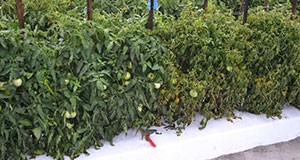 Bs2 tomatoes are transgenic tomatoes that have been engineered to contain the Bs2 gene from pepper. As such, they are considered a genetically modified (GM) food, or a genetically modified organism (GMO). Numerous trials conducted by University of Florida researchers have shown the benefits of these cultivars for bacterial spot disease management, and growers and industry members recognize the potential for Bs2 tomatoes to make Florida tomato production more sustainable. This 4-page fact sheet discusses the benefits that might be realized by the adoption of Bs2 tomato varieties, and the challenges standing in the way of their commercial production. Written by S. F. Hutton, J. W. Scott, J. B. Jones, R. E. Stall, G. E. Vallad, B. J. Staskawicz, and D. M. Horvath , and published by the UF Department of Horticultural Sciences, April 2015.
Bs2 tomatoes are transgenic tomatoes that have been engineered to contain the Bs2 gene from pepper. As such, they are considered a genetically modified (GM) food, or a genetically modified organism (GMO). Numerous trials conducted by University of Florida researchers have shown the benefits of these cultivars for bacterial spot disease management, and growers and industry members recognize the potential for Bs2 tomatoes to make Florida tomato production more sustainable. This 4-page fact sheet discusses the benefits that might be realized by the adoption of Bs2 tomato varieties, and the challenges standing in the way of their commercial production. Written by S. F. Hutton, J. W. Scott, J. B. Jones, R. E. Stall, G. E. Vallad, B. J. Staskawicz, and D. M. Horvath , and published by the UF Department of Horticultural Sciences, April 2015.
http://edis.ifas.ufl.edu/hs1259
Pest Management of Peppers in Miami-Dade County, Florida
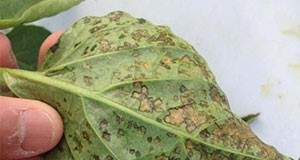
Pest management of peppers in Miami-Dade County is challenging because of a climate favorable to pests. To assist local pepper growers in maintaining crop productivity and improving the quality of produce, this publication illustrates common pests including major diseases and insects and recommends Integrated Pest Management (IPM) techniques, including host resistance, cultivation, sanitation, and physical, mechanical, biological, and chemical approaches, for effective pest management. This 8-page fact sheet was written by Qingren Wang, Shouan Zhang, Dakshina Seal, and Teresa Olczyk, and published by the UF Department of Plant Pathology, February 2015. (Photo: Shouan Zhang)
http://edis.ifas.ufl.edu/pp316
Effects of Harvest Method on Microclimate in Florida Sugarcane
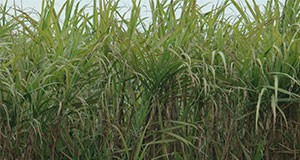 The production systems for sugarcane include either green cane or burnt cane harvesting operations. Sugarcane in Florida is typically harvested with burnt cane mechanical harvesting, but there is a growing interest to better understand the effects of green cane harvest residue “trash blankets” on microclimate conditions for sugarcane growing on both organic and mineral soils of Florida, so the authors conducted a three-year study to determine the effects of each harvest method on microclimate within the surface soil profile and at a 10 cm height from the soil surface. Results are presented in this 4-page fact sheet written by Hardev Sandhu, Maninder Singh, Robert Gilbert, Kelly Morgan, Ronald Rice, Leslie Baucum, James Shine Jr., and Mike Irey, and published by the UF Department of Agronomy, April 2015. (UF/IFAS Photo: Josh Wickham.)
The production systems for sugarcane include either green cane or burnt cane harvesting operations. Sugarcane in Florida is typically harvested with burnt cane mechanical harvesting, but there is a growing interest to better understand the effects of green cane harvest residue “trash blankets” on microclimate conditions for sugarcane growing on both organic and mineral soils of Florida, so the authors conducted a three-year study to determine the effects of each harvest method on microclimate within the surface soil profile and at a 10 cm height from the soil surface. Results are presented in this 4-page fact sheet written by Hardev Sandhu, Maninder Singh, Robert Gilbert, Kelly Morgan, Ronald Rice, Leslie Baucum, James Shine Jr., and Mike Irey, and published by the UF Department of Agronomy, April 2015. (UF/IFAS Photo: Josh Wickham.)
http://edis.ifas.ufl.edu/sc100
Western Flower Thrips (Frankliniella occidentalis [Pergande])
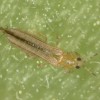 One of many species of thrips found in Florida, Frankliniella occidentalis is a pest of several crops throughout Florida and the world, causing injury by feeding and by transmission of plant viruses. This 8-page fact sheet was written by Jeffrey D. Cluever, Hugh A. Smith, Joseph E. Funderburk, and Galen Frantz, and published by the UF Department of Entomology and Nematology, April 2015. (Photo: Lyle Buss)
One of many species of thrips found in Florida, Frankliniella occidentalis is a pest of several crops throughout Florida and the world, causing injury by feeding and by transmission of plant viruses. This 8-page fact sheet was written by Jeffrey D. Cluever, Hugh A. Smith, Joseph E. Funderburk, and Galen Frantz, and published by the UF Department of Entomology and Nematology, April 2015. (Photo: Lyle Buss)
http://edis.ifas.ufl.edu/in1089
Sting Nematode Belonolaimus longicaudatus Rau (Nematoda: Tylenchida: Belonolaimidae)
 Among the most destructive plant-parasitic nematodes to a wide range of plants, Belonolaimus longicaudatus damages plant roots. When the plants cannot take up water and nutrients from the soil, they become stunted, wilt, and with severe infestation, die. Florida is considered to be the point-of-origin for Belonolaimus longicaudatus and therefore this nematode exhibits a great deal of diversity in morphology, host preference, and genetics in our region. This 6-page fact sheet was written by W. T. Crow, and published by the UF Department of Entomology and Nematology, March 2015. (Photo W. T. Crow, UF/IFAS)
Among the most destructive plant-parasitic nematodes to a wide range of plants, Belonolaimus longicaudatus damages plant roots. When the plants cannot take up water and nutrients from the soil, they become stunted, wilt, and with severe infestation, die. Florida is considered to be the point-of-origin for Belonolaimus longicaudatus and therefore this nematode exhibits a great deal of diversity in morphology, host preference, and genetics in our region. This 6-page fact sheet was written by W. T. Crow, and published by the UF Department of Entomology and Nematology, March 2015. (Photo W. T. Crow, UF/IFAS)
http://edis.ifas.ufl.edu/in1080
Anagyrus pseudococci Girault (Insecta: Hymenoptera: Encyrtidae)
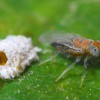 Anagyrus pseudococci is an economically important biological control agent commonly used against the vine mealybug (which infests wine grapes) and the citrus mealybug. It is a solitary, internal parasitoid and lays one egg per host, with the larva developing inside the host’s body. The wasps may be commercially reared and distributed inside mummies, and they will emerge within 1-5 days after delivery. Application involves placing a bottle containing the mummies in a dry spot of the crop and allowing the adults to emerge. This 5-page fact sheet was written by Theresa Chormanski and Ronald D. Cave, and published by the UF Department of Entomology and Nematology, March 2015. (Photo: Kent M. Dane)
Anagyrus pseudococci is an economically important biological control agent commonly used against the vine mealybug (which infests wine grapes) and the citrus mealybug. It is a solitary, internal parasitoid and lays one egg per host, with the larva developing inside the host’s body. The wasps may be commercially reared and distributed inside mummies, and they will emerge within 1-5 days after delivery. Application involves placing a bottle containing the mummies in a dry spot of the crop and allowing the adults to emerge. This 5-page fact sheet was written by Theresa Chormanski and Ronald D. Cave, and published by the UF Department of Entomology and Nematology, March 2015. (Photo: Kent M. Dane)
http://edis.ifas.ufl.edu/in1081
Pepper Production in Miami-Dade County, Florida
 Pepper is an important vegetable crop in Miami-Dade County. Unlike other vegetable crops, peppers are relatively more adaptable to the environment, especially the heat, and are relatively easier to grow. But to be successful, careful attention must be paid to maintain healthy plants and high productivity with efficient management of soil and water for the particular needs of each variety or cultivar. This 7-page fact sheet provides general information and guidelines for pepper growers in Miami-Dade County, including major pepper varieties, and their horticultural traits, and fundamental soil and water management requirements. Written by Qingren Wang, Shouan Zhang, Yuncong Li, Dakshina Seal, Waldemar Klassen, and Teresa Olczyk, and published by the UF Department of Horticultural Sciences, February 2015.
Pepper is an important vegetable crop in Miami-Dade County. Unlike other vegetable crops, peppers are relatively more adaptable to the environment, especially the heat, and are relatively easier to grow. But to be successful, careful attention must be paid to maintain healthy plants and high productivity with efficient management of soil and water for the particular needs of each variety or cultivar. This 7-page fact sheet provides general information and guidelines for pepper growers in Miami-Dade County, including major pepper varieties, and their horticultural traits, and fundamental soil and water management requirements. Written by Qingren Wang, Shouan Zhang, Yuncong Li, Dakshina Seal, Waldemar Klassen, and Teresa Olczyk, and published by the UF Department of Horticultural Sciences, February 2015.
http://edis.ifas.ufl.edu/tr010
Biochar Effects on Weed Management
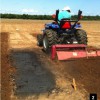 Biochar can potentially provide better conditions in the soil to increase plant growth. However, research has shown that weed species show minimal changes in germination and emergence patterns with the addition of biochar. Regardless, if biochar is used in the field it is important to monitor for changes in weed populations. This is especially important because biochar can decrease herbicide efficacy. This 2-page fact sheet was written by Neeta Soni, Ramon G. Leon, John E. Erickson, and Jason A. Ferrell, and published by the UF Department of Agronomy, March 2015. (Photo: Neeta Soni)
Biochar can potentially provide better conditions in the soil to increase plant growth. However, research has shown that weed species show minimal changes in germination and emergence patterns with the addition of biochar. Regardless, if biochar is used in the field it is important to monitor for changes in weed populations. This is especially important because biochar can decrease herbicide efficacy. This 2-page fact sheet was written by Neeta Soni, Ramon G. Leon, John E. Erickson, and Jason A. Ferrell, and published by the UF Department of Agronomy, March 2015. (Photo: Neeta Soni)
http://edis.ifas.ufl.edu/ag390
Sugarcane Mosaic
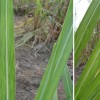 Mosaic’s most distinctive symptom is a pattern of contrasting shades of green, often islands of normal green on a background of paler green or yellowish chlorotic areas on the leaf blade. It had not been a problem in Florida until 1996, when it was observed on CP72-2086, a major commercial cultivar, near the intersection of Hatton Highway and US 98. Presently, because of the limited acreage of CP72-2086, the disease is only a potential threat. This 3-page fact sheet was written by P. Rott, J. C. Comstock, R. A. Gilbert, and H. S. Sandhu, and published by the UF Department of Agronomy, February 2015. (Photo: Philippe Rott, UF/IFAS)
Mosaic’s most distinctive symptom is a pattern of contrasting shades of green, often islands of normal green on a background of paler green or yellowish chlorotic areas on the leaf blade. It had not been a problem in Florida until 1996, when it was observed on CP72-2086, a major commercial cultivar, near the intersection of Hatton Highway and US 98. Presently, because of the limited acreage of CP72-2086, the disease is only a potential threat. This 3-page fact sheet was written by P. Rott, J. C. Comstock, R. A. Gilbert, and H. S. Sandhu, and published by the UF Department of Agronomy, February 2015. (Photo: Philippe Rott, UF/IFAS)
http://edis.ifas.ufl.edu/sc009
Squash Vine Borer Melittia cucurbitae (Harris) (Insecta: Lepidoptera: Sesiidae)
 Squash vine borer is a moth species that is active during the day (diurnal). The larvae complete their growth and development on wild and domesticated species of the genus Cucurbita. Once only considered a nuisance to commercial growers, with the expansion of cucurbit production in the United States over the last decade, the squash vine borer has become a pest of economic importance. This 5-page fact sheet was written by Eutychus Kariuki and Jennifer L. Gillett-Kaufman, and published by the UF Department of Entomology and Nematology, December 2014. (Photo: Lyle J. Buss, UF/IFAS)
Squash vine borer is a moth species that is active during the day (diurnal). The larvae complete their growth and development on wild and domesticated species of the genus Cucurbita. Once only considered a nuisance to commercial growers, with the expansion of cucurbit production in the United States over the last decade, the squash vine borer has become a pest of economic importance. This 5-page fact sheet was written by Eutychus Kariuki and Jennifer L. Gillett-Kaufman, and published by the UF Department of Entomology and Nematology, December 2014. (Photo: Lyle J. Buss, UF/IFAS)
http://edis.ifas.ufl.edu/in1068
Rice Bug (suggested common name) Leptocorisa acuta (Thunberg) (Insecta: Hemiptera: Alydidae)
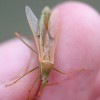 Broad-headed bugs belong to a well-known but relatively small family of plant-feeding true bugs, usually seen feeding on the foliage and flowers of leguminous and graminaceous crops. Leptocorisa acuta (Thunberg) can be found on many crop plants in the family Poaceae (grasses), especially rice, and is a reported pest of economic significance in rice-producing countries like India, Australia, and China. This 3-page fact sheet was written by Amelio Chi Serrano, Russell F. Mizell, III, and Morgan A. Byron, and published by the UF Department of Entomology and Nematology, December 2014. (Photo: Lary E. Reeves, UF/IFAS)
Broad-headed bugs belong to a well-known but relatively small family of plant-feeding true bugs, usually seen feeding on the foliage and flowers of leguminous and graminaceous crops. Leptocorisa acuta (Thunberg) can be found on many crop plants in the family Poaceae (grasses), especially rice, and is a reported pest of economic significance in rice-producing countries like India, Australia, and China. This 3-page fact sheet was written by Amelio Chi Serrano, Russell F. Mizell, III, and Morgan A. Byron, and published by the UF Department of Entomology and Nematology, December 2014. (Photo: Lary E. Reeves, UF/IFAS)
http://edis.ifas.ufl.edu/in1067
Yellowmargined Leaf Beetle: A Pest of Cole Crops
 The yellowmargined leaf beetle is a pest of cole or cruciferous crops that is native to South America. Since first reported in Mobile, Alabama, in 1947, the beetle has spread throughout the Gulf Coast from Texas to Florida and up into Georgia and North Carolina. It has also been reported from Illinois and California. Not considered a major pest in conventionally grown cruciferous crops because it is susceptible to a wide range of insecticides, it poses a significant threat to the growing organic industry in the southeastern United States. It is a particular problem on Asian greens such as mizuna, mibuna, and napa cabbage, as well as on other high-value cruciferous crops like turnip, mustard, and watercress. This 4-page fact sheet was written by Elena M. Rhodes and and Oscar E. Liburd, and published by the UF Department of Entomology and Nematology, September 2014.
The yellowmargined leaf beetle is a pest of cole or cruciferous crops that is native to South America. Since first reported in Mobile, Alabama, in 1947, the beetle has spread throughout the Gulf Coast from Texas to Florida and up into Georgia and North Carolina. It has also been reported from Illinois and California. Not considered a major pest in conventionally grown cruciferous crops because it is susceptible to a wide range of insecticides, it poses a significant threat to the growing organic industry in the southeastern United States. It is a particular problem on Asian greens such as mizuna, mibuna, and napa cabbage, as well as on other high-value cruciferous crops like turnip, mustard, and watercress. This 4-page fact sheet was written by Elena M. Rhodes and and Oscar E. Liburd, and published by the UF Department of Entomology and Nematology, September 2014.
http://edis.ifas.ufl.edu/in1049
Hairy Indigo Control in Peanut
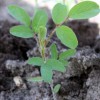 Hairy indigo is an annual legume that was introduced to Florida as a forage crop. It has since escaped cultivation and can be a troublesome weed in some crop settings, particularly in peanut production, since we are attempting to control a legume weed in a legume crop. This 2-page fact sheet was written by Jason Ferrell, Blaire Colvin, and Ramon Leon, and published by the UF Department of Agronomy, March 2015. (Photo by Blaire Colvin, UF/IFAS)
Hairy indigo is an annual legume that was introduced to Florida as a forage crop. It has since escaped cultivation and can be a troublesome weed in some crop settings, particularly in peanut production, since we are attempting to control a legume weed in a legume crop. This 2-page fact sheet was written by Jason Ferrell, Blaire Colvin, and Ramon Leon, and published by the UF Department of Agronomy, March 2015. (Photo by Blaire Colvin, UF/IFAS)
http://edis.ifas.ufl.edu/ag391
Selecting Cultivars of Lettuce For Production Using Hydroponics and Protected Culture in Florida
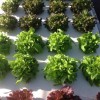 With correct variety selection and protected culture strategies, lettuce is a crop that can present even the novice grower with a fast-growing commodity for market sale. Includes brief descriptions of hydroponic lettuce production systems, cultivars, and a table summarizing the lettuce types successfully grown in Florida using protected agriculture and hydroponic techniques. This 6-page fact sheet was written by Natalie B. Parkell, Robert C. Hochmuth, and Wanda L. Laughlin, and published by the UF Department of Horticultural Sciences, March 2015. (Photo: UF/IFAS)
With correct variety selection and protected culture strategies, lettuce is a crop that can present even the novice grower with a fast-growing commodity for market sale. Includes brief descriptions of hydroponic lettuce production systems, cultivars, and a table summarizing the lettuce types successfully grown in Florida using protected agriculture and hydroponic techniques. This 6-page fact sheet was written by Natalie B. Parkell, Robert C. Hochmuth, and Wanda L. Laughlin, and published by the UF Department of Horticultural Sciences, March 2015. (Photo: UF/IFAS)
http://edis.ifas.ufl.edu/hs1258
Nutrient Management of Vegetable and Agronomic Row Crops Handbook
 Through the implementation of a series of targeted cultural practices discussed in this production guide, growers should be able to reconcile economic profitability and responsible use of water and fertilizer. Topics include: proper sampling practices and test interpretations; irrigation management methods and automation; use of alternate fertilizer materials to retain nutrients in the soil but allow adequate supply for crop uptake. Use of these BMPs ensures that adequate fertilizer rates may be achieved by combinations of UF/IFAS recommended base rates and supplemental fertilizer applications. This 199-page handbook was edited by Kelly T. Morgan, and published by the UF Department of Soil and Water Science, February 2015.
Through the implementation of a series of targeted cultural practices discussed in this production guide, growers should be able to reconcile economic profitability and responsible use of water and fertilizer. Topics include: proper sampling practices and test interpretations; irrigation management methods and automation; use of alternate fertilizer materials to retain nutrients in the soil but allow adequate supply for crop uptake. Use of these BMPs ensures that adequate fertilizer rates may be achieved by combinations of UF/IFAS recommended base rates and supplemental fertilizer applications. This 199-page handbook was edited by Kelly T. Morgan, and published by the UF Department of Soil and Water Science, February 2015.
http://edis.ifas.ufl.edu/ss639
